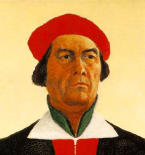Suprematism
From Wikipedia, the free encyclopedia


Suprematism (Russian: Супрематизм): is an art movement focused on fundamental geometric forms (in particular the square and circle) which formed in Russia in 1915-1916.
When Kasimir Malevich originated Suprematism in 1915 he was an established painter having exhibited in the Donkey's Tail and the Der Blaue Reiter (The Blue Rider) exhibitions of 1912 with cubo-futurist works. The proliferation of new artistic forms in painting, poetry and theatre as well as a revival of interest in the traditional folk art of Russia were a rich environment in which a Modernist culture was being born.
In his book The Non-Objective World, which was published abroad as a Bauhaus Book in 1927, Malevich described the inspiration which brought about the powerful image of the black square on a white ground:
- I felt only night within me and it was then that I conceived the new art, which I called Suprematism.
Malevich also ascribed the birth of Suprematism to Victory Over the Sun, Kruchenykh's Futurist opera production for which he designed the sets and costumes in 1913. One of the drawings for the backcloth shows a black square divided diagonally into a black and a white triangle. Because of the simplicity of these basic forms they were able to signify a new beginning.
He created a Suprematist 'grammar' based on fundamental geometric forms; in particular, the square and the circle. In the 0.10 Exhibition in 1915, Malevich exhibited his early experiments in Suprematist painting. The centerpiece of his show was the Black square on white, placed in what is called the red/beautiful corner in Russian Orthodox tradition ; the place of the main icon in a house.
Another important influence on Malevich were the ideas of the Russian mystic-mathematician, philosopher, and disciple of Georges Gurdjieff; P. D. Ouspensky who wrote of "a fourth dimension or a Fourth Way beyond the three to which our ordinary senses have access".[1]

Some of the titles to paintings in 1915 express the concept of a non-euclidian geometry which imagined forms in movement, or through time; titles such as: Two dimensional painted masses in the state of movement. These give some indications towards an understanding of the Suprematic compositions produced between 1915 and 1918.
The Supremus group which, in addition to Malevich included Aleksandra Ekster, Olga Rozanova, Nadezhda Udaltsova, Anna Kagan, Ivan Kliun, Liubov Popova, Nikolai Suetin, Ilya Chashnik, Lazar Khidekel, Nina Genke-Meller, Ivan Puni and Ksenia Boguslavskaya met from 1915 onwards to discuss the philosophy of Suprematism and its development into other areas of intellectual life. There was some crossover with Constructivism, with Suprematists such as Popova and especially El Lissitzky working on propaganda and industrial design. Lissitzky spread Suprematist ideas abroad in the early 1920s. In addition, Nikolai Suetin used Suprematist motifs on works at the St Petersburg Lomonosov Porcelain Factory, where Malevich and Chashnik were also employed, with Malevich designing a Suprematist teapot. The Suprematists also made architectural models in the 1920s, which offered a different conception of socialist buildings to those developed in Constructivist architecture.
This development in artistic expression came about when Russia was in a revolutionary state, when ideas were in ferment and the old order was being swept away. As the new order became established, and Stalinism took hold from 1924 on, the state began limiting the freedom of artists.

From the late 1920s the Russian avant-garde experienced direct and harsh criticism from the authorities and in 1934 the doctrine of Socialist Realism became official policy, and prohibited abstraction and divergence of artistic expression. Malevich nevertheless retained his main conception. In his self-portrait of 1933 he represented himself in a traditional way — the only way permitted by Stalinist cultural policy — but signed the picture with a tiny black-over-white square.
[edit] References
- ^ (Gooding, 2001)
[edit] Sources
- Kasimir Malevich, The Non-objective World. English translation, Paul Theobald and Company, 1959
- Camilla Gray, The Russian Experiment in Art, Thames and Hudson, 1976
- Mel Gooding, Abstract Art, Tate Publishing, 2001
[edit] External links
- New Statesman on Suprematist Porcelain
- smARThistory: Malevich, Suprematist Composition: White on White]
|
|||||||||||||||||||
|
||||||||||||||


